Spica is the brightest star in the constellation of Virgo, and one of the 20 brightest stars in the night sky. It is the 17th brightest star, and it is a spectroscopic binary star being a rotating ellipsoidal variable.
Key Facts & Summary
- The binary star system Spica is made out of two stars that are so close to each other that they are egg-shaped rather than spherical, and they can only be separated by their spectra.
- The primary star is a blue giant and a variable star of the Beta Cephei type. Its spectral type is B1V ( B1 III-IV).
- Analysis of its parallax shows that it is located at around 250 light-years / 77 parsecs away from the Sun.
- Spica, along with Arcturus and Regulus, are part of the Spring Triangle asterism, and by extension, also of the Great Diamond together with the star Cor Caroli.
- Since Spica is 2.06 degrees from the ecliptic, it can be occulted by the Moon and sometimes other planets.
- Once every 8 years, Venus passes in front of Spica around the time of the star’s heliacal rising.
- Spica is around 20.512 times brighter than our sun and much hotter with surface temperatures at around 25.300 K.
- The secondary Spica star is 2.254 times brighter than our sun and again much hotter, at an average surface temperature of around 20.900 K.
- The primary Spica star has around 11.43 times the sun’s mass while the secondary Spica star has around 7.21 solar masses.
- Both stars have greater radii than our sun, with the primary Spica star having around 7.47 solar radii and the secondary Spica star having around 3.74 solar radii.
- Spica has an apparent magnitude of +0.97 and it variates between 0.97 and 1.04. Its absolute magnitude is -3.55 and it also varies between -3.5 and -1.5.
- The stars orbit each other once every four days and they are so close to one another that they cannot be resolved as two stars through a telescope.
Since it is one of the nearest massive binary star systems, Spica has been the subject of many observational studies. It is widely speculated that Spica gave the greek astronomer Hipparchus (160 – 120 B.C.), the needed data that led him to discover the precession of the equinoxes.
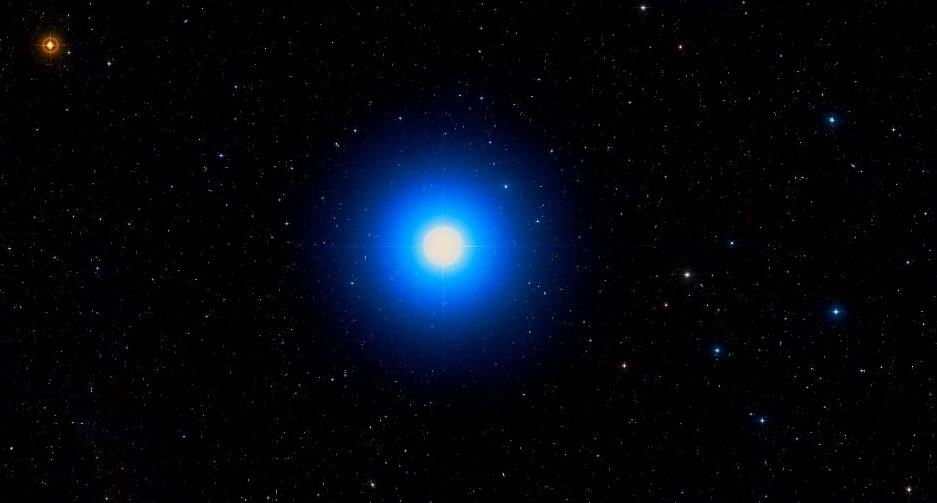
One temple dedicated to Menat (early Hathor), in Thebes, was oriented with reference to Spica when it was built in 3.200 B.C. As time passed, precession slowly but noticeably changed Spica’s location relative to the temple.
Even the famous inventor of the heliocentric model, Nicolaus Copernicus, made many observations of Spica with his home-made triquetrum ( ancient astronomical device), for his researches on precession.
The name Spica derives from Latin and it translates to “the virgin’s ear of (wheat) grain.” The Latin word “spicum” refers to the ear of wheat Virgo holds in her left hand. Its name was also anglicized as Virgin’s Spike while Johann Bayer cited the name Arista.
Formation
Spica is estimated to have formed around 12.5 million years ago from a cloud of dust and gas. Gravity pulled the swirling gas and dust together to form the star that we today now see as Spica. It is unclear whether both stars formed at the same time or separately and somehow ended up together.
Distance, Size, and Mass
Analysis of Spica’s parallax shows that it is located at around 250 ± 10 light-years / 77 ± 4 parsecs away from the Sun. Both stars are several times bigger than our Sun. The primary Spica star has around 11.43 times the sun’s mass while the secondary Spica star has around 7.21 solar masses.
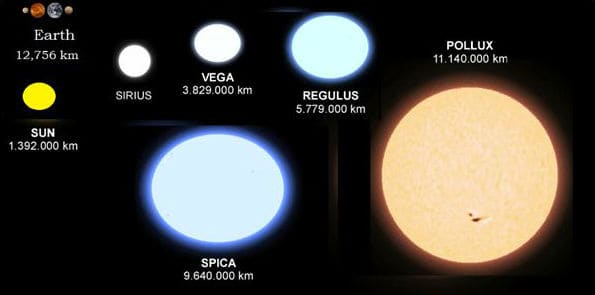
Both stars have greater radii than our sun, with the primary Spica star having around 7.47 solar radii thus a diameter of around fourteen times that of the sun. The secondary Spica star has around 3.74 solar radii, thus around seven times the sun’s diameter.
Star System – Other Characteristics
The primary Spica star is around 20.512 times brighter than our sun and much hotter with surface temperatures at around 25.300 K.
The secondary Spica star is 2.254 times brighter than our sun and again much hotter, at an average surface temperature of around 20.900 K. Spica as a whole, has an apparent magnitude of +0.97 and it variates between 0.97 and 1.04. Its absolute magnitude is -3.55 and it also varies between -3.5 and -1.5.
They orbit each other once every four days at an extremely close distance of 0.12 AU. The stars orbit a common barycenter at about 56 mi / 90 km per second at a distance of only 18 million km / 11 million miles.
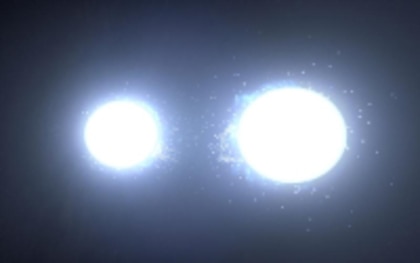
Because of their close proximity, their gravities distorts both stars into an egg-shape, with their pointing ends facing each other. Slight changes in magnitude may be evidence that they are distorted by their interaction. The Spica system is classified as a double-lined spectroscopic binary. Their apparent diameter changes over the course of an orbit.
The secondary Spica star belongs to the spectral class B2V – this means that it is still on the main-sequence. Another result of their close proximity is their stellar wind interactions that cause massive sources of X-rays. The primary Spica star is a very fast spinner, with a projected rotational velocity of 199 km / 123 mi per second at the equator. The primary Spica star is halfway between a blue subgiant and a blue giant on the evolutionary stage. Its spectral class if B1 III-IV. The secondary Spica star is impossible to distinguish with a telescope due to its proximity and the fact that the primary Spica star exhibits 80% of its systems light.
Location
Spica is located in the zodiacal constellation of Virgo. It is the alpha star, the brightest in the constellation marking the ear of grain in the celestial Virgo’s left hand.
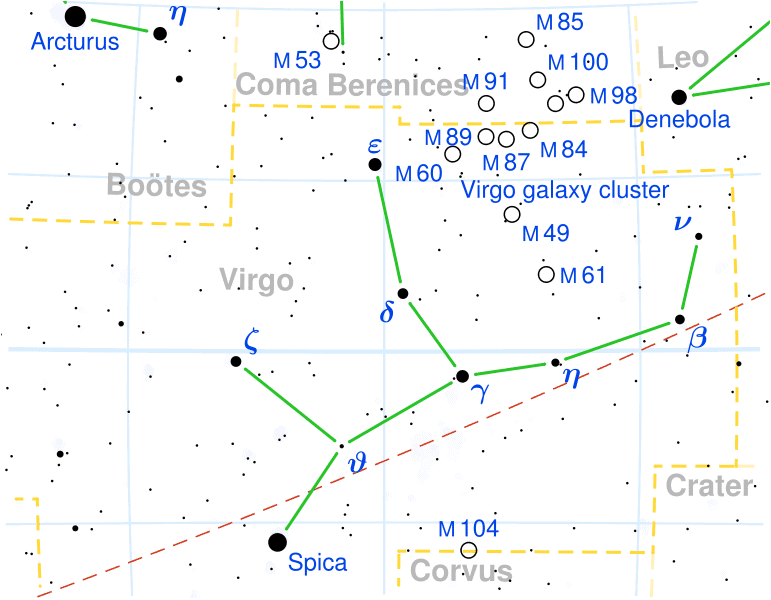
This constellation is the second largest in the night sky, after Hydra. It is one of the Greek constellations, first listed by Ptolemy in the 2nd century C.E.
An easy way to find Spica is by following the arc of the Big Dipper’s handle which is formed by the Alkaid, Mizar, and Alioth bright stars. The blue star Spica is part of two prominent spring asterisms. The first is the Spring Triangle.
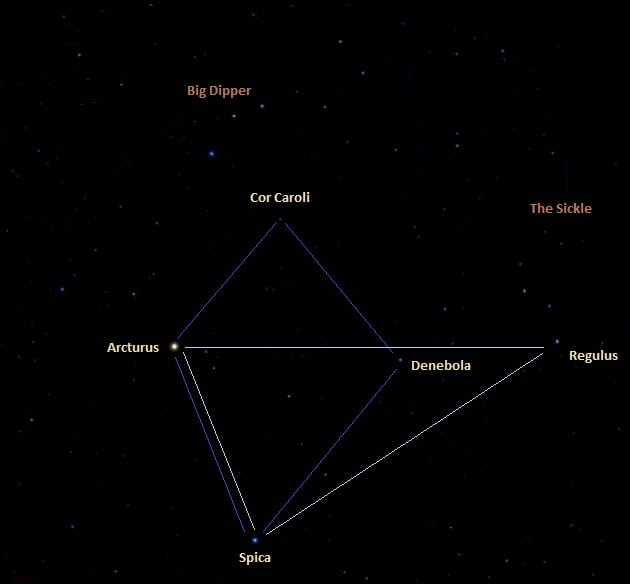
The Spring Triangle asterism is formed by Spica, Arcturus, and Regulus. The second asterism that features Spica is called the Great Diamond or the Diamond of Virgo.
The Diamond of Virgo consists of Spica, Arcturus, Denebola in Leo, and Car Caroli the luminary of Canes Venatici. The constellation of Virgo contains many interesting objects. It even contains 11 Messier objects.
Another interesting association is with the Behenian fixed stars. In medieval astrology, Spica was part of the fifteen Behenian stars who were believed to have an influence on the planets and a source of astrological power or even magic. Spica was associated with the planets Mercury and Venus and it was also associated with the emerald and sage – which were rituals to bring out the star’s influence.
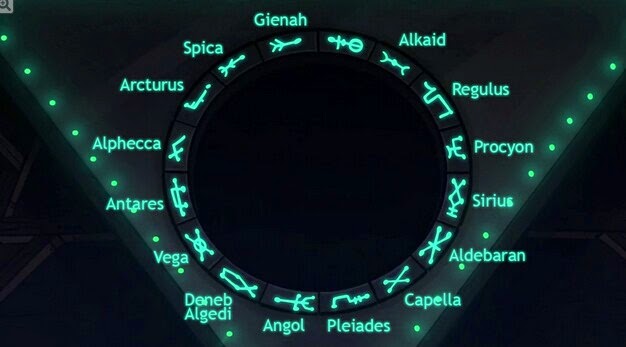
The Future
The primary Spica star is halfway between a subgiant and a giant on the evolutionary stage. Because of this, and its enormous mass, it is believed that the star is massive enough to end its life in a supernova explosion of Type II.
Did you know?
- The best time to observe the stars and deep-sky objects situated in the Virgo constellation is during the month of May.
- The best time to observe Spica, in particular, is from spring to late summer. It emerges on the horizon in the east-southeast at sunset in mid-April.
- The star’s projected galactic orbit takes Spica between 22.500 and 24.400 light-years from the centre of the Milky Way.
- Spica moves at a speed of 18.9 km / 11.7 mi per second relative to the sun.
- Many temples other than the one in Thebes were oriented towards Spica. Some of these temples are:
- The temple of the Sun at Tell el-Amarna 2.000 B.C., two temples at Rhamnus in Greece 1092 – 747 B.C., two temples at Tegea, the goddess Hera’s temples at Olympia 1.445 B.C., the temple of Nike Apteros at Athens 1.130 B.C., and the temple of Diana of the Ephesians 715 B.C.
- Since so many temples were oriented towards Spica, it is an indication that many cultures had knowledge of the precession of the equinoxes much earlier than Hipparchus documented his discovery.
- Spica and the constellation of Virgo, are often associated with Demeter, and Dike, the goddess of justice in ancient Greek culture.
- The Egyptians identified Virgo with the goddess Isis and attributed Spica as Isis’ Lute bearer.
- The flag of Brazil is represented by 27 stars – each symbolizes a Brazilian Federative Unit. Spica is one of those stars and it represents the state of Para. It is also the only star above the white band, symbolizing a part of the territory north of the equator.
- The autumnal equinox lies mid-way between Spica and Regulus.
- The only star in the constellation of Virgo selected for navigation is Spica. A total of 58 bright make up the field of celestial navigation due to their brightness and because they are easily identifiable.
- The last time Spica was occulted by a planet happened in 1783, when it was occulted by the terrestrial planet, Venus.
Sources:
Image source:
- https://www.star-facts.com/wp-content/uploads/2019/10/Spica.jpg?189db0&189db0
- https://img.bhs4.com/3f/b/3fb3982655ed315e3d963b731be142cb7c77ea2f_large.jpg
- https://en.es-static.us/upl/2017/04/spica-artist.jpg
- https://upload.wikimedia.org/wikipedia/commons/thumb/8/85/Virgo_constellation_map.svg/771px-Virgo_constellation_map.svg.png
- https://www.star-facts.com/wp-content/uploads/2019/09/Spring-Triangle-and-Great-Diamond.jpg
- https://cayelincastell.com/wp-content/uploads/2017/10/behenian-star-glyphs.jpg
